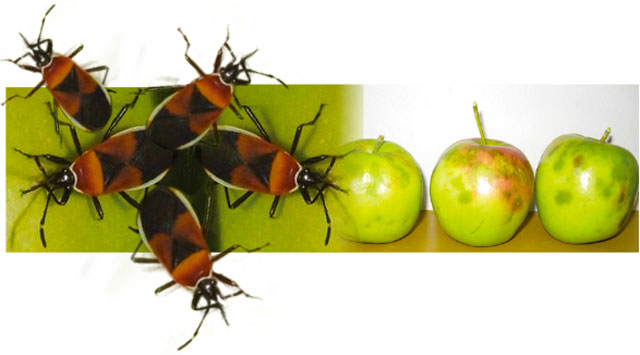The harlequin bug is a native Australian plant bug.
It was documented as a pest of pome and stone fruits in the 1950s. However, between then and the 1990s the use of synthetic insecticides may have suppressed harlequin bug numbers to the point where it was no longer considered a significant pest.
More recently, the increasing adoption of integrated pest management (IPM) and the associated decline in using broad-spectrum insecticides are thought to have resulted in a resurgence of this pest (particularly in apple orchards) across south-eastern NSW.
Pest identification
The adult harlequin bug is about 12 mm long and is very conspicuous. The head and inner margins and tips of the forewings are black, the thorax and base of the forewings are reddish-orange. The underside of the body is tinged with yellow or green and bears some red and black markings.
The harlequin bug develops through five immature stages or instars and is often found swarming in large numbers on native tree trunks, trellis and hail netting posts and in sheds.
Mating adults can be seen moving in pairs joined at the abdomen and facing in opposite directions.
Damage
The harlequin bug is a sap-sucker that uses a proboscis (needle-like mouthpart) to pierce the skin of the host plant tissue.
On fruit, this feeding results in slight depressions on the skin of the apple and is associated with the browning of the underlying flesh. The damage could be easily confused with that of boron deficiency (cork disorder).
Monitoring
Common orchard weeds such as Malva spp. (marshmallow), Rumex spp. (docks) and Polygonum aviculare (wire weed) are known hosts and should be the focus of monitoring and weed control programs.
Inspect weeds, timber stacks, trellises, netting structures and nearby native bush for harlequin bug colonies.
Management
Cultural and physical
The severity of damage in some orchards seems to be associated with the bugs having easy access to the trees via weed growth within the tree row and/or canopy, low growing branches, nearby trellis posts or wires and irrigation tubes.
Because of its association with certain weed species, good weed control in the orchard is key to reducing the likelihood and intensity of infestations.
Particular attention should be given to removing and controlling common orchard weeds, especially marshmallow, dock and wireweed.
Removing sheltering sites such as timber stacks and other rubbish from within the orchard should also help reduce bug numbers.
Biological
There are no known biological control agents for the harlequin bug.
Chemical
As there are presently no chemicals registered for the control of harlequin bug in orchards in Australia, management of the pest is dependent on the adoption of cultural practices.
Download the Orchard plant protection guide
See this article in Tree Fruit February 2022




















